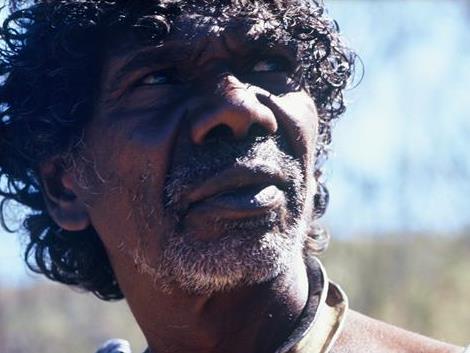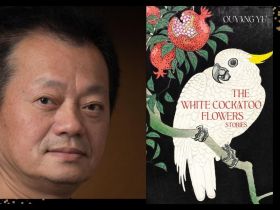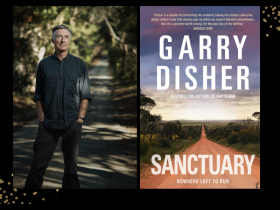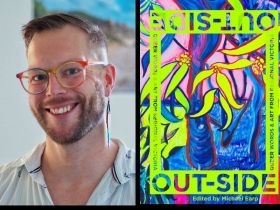David Gulpilil in The Tracker
At Byron Bay Writers Festival recently a young writer in the audience, perhaps in her early twenties, stood up. She told the room that three Aboriginal characters had recently ‘come to her’, mysteriously, she knew not from whence, and she posed the question of whether it was alright for her to write these characters in her novel. A total stranger, she sought our blessing in a very public forum. The three Aboriginal writers on the panel all paused, a very familiar pause, and in that space I knew I had to speak, to do what Uncle Charlie Perkins instructed. Uncle Charlie said that its part and parcel of being Aboriginal that you often have to ‘say things you don’t want to say, and you have to offend people who you would otherwise be friends with, because if you don’t say those things then who will, and otherwise how is anything about our lives going to change?’
My life as an Aboriginal person is one of daily and weekly letting things slide. But at Byron I felt I had to speak, and so I told this young kid a blunt no. Don’t do it. Write what you know. She sat down, no doubt disappointed, and the conversation then wheeled and turned around ideas of representation and authenticity and freedom of the artistic imagination for the next little while. Tony Birch made a kind of a show at disagreeing with me but essentially none of us on the panel could muster very much dissent.
Later on in the Festival café the young writer came up to where I was taking a rare chance to chat with Anita Heiss and the young writer took my marginal willingness to listen to her for a moment or two to be an invitation to sit down. Then she proceeded to tell me that she completely understood the statement I’d made from the lectern. She repeated this phrase several times -that she ‘completely understood’. Naturally, if anything could have told me that I was wise in my advice to her, this highly irritating phrase did. David Foster Wallace said that there is no such thing as true empathy and he was right. Our attempts to live in the skins of others are at best stabs at the approximate.
The young writer (who, up close, turned out to be not that young after all, perhaps pushing thirty, and old enough to know better) didn’t know where her three fictional Aborigines had come from, but I did. They had come to her straight from the great poisoned well of historic writing of Aboriginal people, and she was asking permission to recycle one of the following classic tropes of white writing on Aboriginal life…. The Aborigine as Doomed Innocent or The Tragic Aboriginal Incompetent…
The Aborigine who embodies both health and competence has historically been extremely rare in outsider writing, at least since Cook upped anchor. Those white writers sympathetic to Aboriginal society have usually been at pains to show the ways we’ve been wronged. With rare exceptions – Allan Marshall in his memoir of the remote Northern Territory These Were My Tribesman is one – the Aboriginal is thus shown suffering impotently in all his incompetence and misery and then figuratively left for dead. Kenneally’s Jimmy Blacksmith is in lots of ways a terrific anti-hero, an angry defiant black man who explicitly declares war upon those who have wronged him, and in that sense at least exerts some decision making over his life. It’s not a bad book. It’s an insightful book, though it presents a very white view of the world through Jimmy’s eyes. It’s probably the best book a non-Aboriginal author could have penned, for its time. But he’s still a victim. Kenneally says it on the page: ‘Healey, Lewis, now Newby, had each staked his soul on Jimmy’s failure.’
***
This kind of fable may bring great psychological satisfaction to those Australians, black, white and yellow, who still need the Aborigine to stand as a symbol of Death or Despair. It might be of some value in helping them therapeutically shed tears of guilt or displaced rage at our plight. And it may be of some real use in educating those who still don’t know our hideous history. But it is of almost no use whatsoever in getting Aboriginal people onto the page as real, live, characters with agency, with character arcs, and with futures that both acknowledge and transcend death and suffering and hopelessness.
I read over a hundred film scripts each year, and as a result a torrent of non-Aboriginal depictions of us floods across my desk each month. Some of these scripts are well written with a degree of insight and sophistication about Aboriginal communities. Confidentiality unfortunately prevents me from revealing the excruciating badness of many of the others. But in the fifteen years I have been reading what non-Aboriginal writers feel might be entertaining about Aboriginality in film, I have grown terribly weary of imagined one-dimensional Aboriginal Elders who launch, unprovoked, into public expositions about their traditional stories in order that white strangers may be brought into the Dreaming. I have grown weary of drunken Aboriginals lurking menacingly in the margins in Act One, and even wearier of the escalating Aboriginal male body count at the end of Act Two. I have ceased to be surprised when white male leads save the Aboriginal Tonto from those other ‘bad’ whites, and I have been only mildly amazed when an intended Aboriginal hero literally dragged a young Aboriginal woman off over rocky ground by her hair. So when I began to wonder where I might find the clever, farsighted, skilled and bold little Aboriginal pig – in Australian representations of us, I wasn’t holding out a great deal of hope.
Richard Flanagan’s Wanting was on my list of possibles – but then his main Aboriginal character, well-drawn and skilfully rendered in many ways, finishes the novel face down dead at seventeen in the mud of a Hobart street. Kate Grenville’s The Secret River, a book I admire a great deal, was another on the list. I advised Kate not to write about the colonial era in an Aboriginal voice but from a white perspective. She took my advice and has been criticised by some, including Uncle Bruce Pascoe, for doing so. I disagree, and think The Secret River is an extremely important book. But for all its exceptional portrayal of colonial mores and its honesty about white colonial conspiracies of violence, this novel is ultimately about Solomon Wisemans’ fate, and not about the future of the Eora people he displaced. No third pig there. Similarly with Peter Goldsworthy’s Three Dog Night and Andrew Boval’s Holy Day. Both excellent stories, the former informed by Peter’s long and sophisticated understanding of the Walpiri, and a very real relationship with those desert communities, but again, both are books more for White Australians than books showing us Aborigines defeating the Wolf.
David Foster has written of Aboriginal lives in both fiction and non-fiction, I gather based largely upon time he spent in the Northern Territory during the Eighties. But after reading him describe Aboriginal characters living in New South Wales as “long-grassers” – a term exclusively used in Australia’s north – and reading him argue that the Aboriginal children his white son fathered with a black woman in Darwin aren’t “really” Aboriginal, I felt no compulsion to explore Foster’s ideas of my people in literature any further.
About this time, I began to think that it is the individualistic nature of the novel that’s part of the problem. Novelists are almost never forced to collaborate with anyone except publishers and editors – which is another essay in itself. But film-makers are by the very nature of the business required to work with actors, with other writers, with crew, with a whole gamut of other human beings for extended periods. And so it was, after considering and finally dismissing Alex Miller’s Journey to the Stone Country, and Nene Gares’ oh-so-close The Fringe-Dwellers, with her heroic young Phyllix in its final pages, that I turned, ultimately, to film.
In 1993 I saw Rolf de Heer’s Bad Boy Bubby. I disliked the film overall, but have never forgotten an Aboriginal character, a woman, who in a fraught encounter with police spits out in frustration that she needs to get to work. In a decade when the portrayal of Aborigines as ordinary people, and workers to boot, was still highly unusual, this contemporary urban character struck me as a significant step forward.
A decade later De Heer, collaborating with the gigantic talents of Gulpilil and Roach, brought us his masterpiece The Tracker. As Gulpilil sheds the white man’s chains over the course of this film, and transitions from servile tool of the Fanatic to the man literally in the saddle, we slowly see not just The Tracker morphing into the leader of the expedition, but also find our own ignorance and prejudices revealed.
Deliberately mytho-poetic in its tone, magnificent in its scope and insight, The Tracker gave Aboriginal people what had been missing for two centuries in white writing – an Aboriginal lead with an astonishing narrative arc, with power and dignity and intelligence, who outwits the Wolf, and remains alive and triumphant at the end of the film.
****
In art, Australia needs Aboriginal heroes and Aboriginal Everymen and Everywomen. We need living Aboriginal characters, Aborigines who have never seen inside jail cells or paddy wagons, Aborigines who can thrive, emotionally, spiritually and economically, and bring The Good Life to the stories they inhabit. I wrote Mullumbimby because I wanted a novel to exist where Aboriginal people had four things: Beauty. Power. Humour. And Land. These are four things we must retain if our lives are to become what they should.
But we still live in a country where our humanity is daily undermined. Where good men and women do little, or do nothing. Where virulent anti-Aboriginal racism goes very often unchecked on our airwaves and in our national conversations. These things matter, just as our vile treatment of refugees who come here seeking help from one of the world’s rich, lucky countries matters. It matters to the core of who we are and who we want to be. And while the three little pigs is one of Western Europe’s oldest stories, since 9/11 another fable has entered the consciousness of the West. This is the fable of Sudden, Shocking Death from Above, of the Great brought Low.
A lot of Australians would class my ideas here tonight as political correctness. A lot of Australians think that the tales we tell ourselves about the poorest in our society don’t matter much. But if you think that young Aboriginal men and women can be routinely raised in poverty, or brutalised and criminalised without consequence, then I draw your attention to the words of an Aboriginal man from Western Australia talking about the pub in his town. Concerned about the impact of grog on his people, this Walmajarri man told filmmaker Nicole Ma: ‘Might get onto Bin Laden, eh. Blow that pub up. Blow it off the face of the earth.’
In 1972 Tom Kenneally wrote a Jimmy Blacksmith driven to war by ceaseless torment, by being offered and then cruelly denied a place in this society. That same denial is still happening in a thousand small country towns tonight, where Aboriginal kids have no food on the table, no black teachers in the schools they are expected to attend, few jobs to go to should they finish school, and increasingly, very little to lose by stepping outside the contempt which the white law offers them.
I fear what might happen if Australia doesn’t start believing in the humanity of the Aboriginal population. And I fear too what might happen if our stories continue be sought out and told by ignorant novices, whose Aboriginal characters arise from the ether, without insight or accomplishment, or anything resembling self-reflection. Because unless the proportion of novices to De Heers, or Bill Gammages, or Nene Gares, doesn’t improve, I don’t think it will be long before Australia hears Aboriginal voices knocking at the door, calling to be let in, and when this call is denied, as it almost certainly will be, it may not be long before Australia hears those Aboriginal voices questioning why they shouldn’t huff, and puff, and blow your house down.
This article is an edited extract from Melissa Lucashenko’s Colin Simpson Memorial Lecture presented by the Australian Society of Authors.





